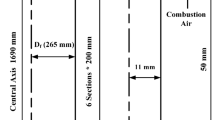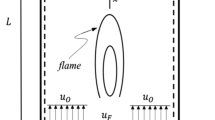Abstract
The buoyancy effect on micro hydrogen jet flames in still air was numerially studied. The results show that when the jet velocity is relatively large (V≥0.2 m/s), the flame height, width and temperature decrease, whereas the peak OH mass fraction increases significantly under normal gravity (g=9.8 m/s2). For a very low jet velocity (e.g., V= 0.1 m/s), both the peak OH mass fraction and flame temperature under g=9.8 m/s2 are lower than the counterparts under g=0 m/s2. Analysis reveals that when V≥0.2 m/s, fuel/air mixing will be promoted and combustion will be intensified due to radial flow caused by the buoyancy effect. However, the flame temperature will be slightly decreased owing to the large amount of entrainment of cold air into the reaction zone. For V=0.1 m/s, since the heat release rate is very low, the entrainment of cold air and fuel leakage from the rim of tube exit lead to a significant drop of flame temperature. Meanwhile, the heat loss rate from fuel to inner tube wall is larger under g=9.8 m/s2 compared to that under g=0 m/s2. Therefore, the buoyancy effect is overall negative at very low jet velocities.
摘要
本文通过数值模拟对静止空气中微射流氢气火焰的浮升力效应进行了研究。结果显示, 当射流 速度相对较大时 (V≥0.2 m/s), 常规重力加速度(g=9.8 m/s2)下的火焰高度、宽度和温度均比无重力作用 时小, 但是OH 的质量分数却显著增大。当射流速度非常小(例如: V=0.1 m/s)时, 常规重力加速度下 OH 质量分数的峰值和火焰温度均小于无重力作用时的对应值。分析表明, 当V≥0.2 m/s 时, 由于浮升 力效应导致的径向流动促进了燃料与空气之间的混合, 从而使燃烧得到强化。然而, 由于大量冷空气 被卷入反应区, 火焰温度略有降低。当V=0.1 m/s 时, 因为热释放速率非常小, 冷空气的卷入和燃料 在管口边缘的泄露导致火焰温度显著下降。与此同时, 有重力作用时从燃料向管子内壁的散热损失更 大。因此, 总的来说浮升力在非常小的射流速度下是负面效应。
Similar content being viewed by others
References
FERNANDEZ-PELLO A C. Micro power generation using combustion: Issues and approaches. Proceedings of the Combustion Institute, 2002, 29: 883–899. DOI: 10.1016/S1540-7489(02)80113-4.
WALTHER D C, AHN J. Advances and challenges in the development of power-generation systems at small scales. Progress in Energy and Combustion Science, 2011, 37: 583–610. DOI: 10.1016/j.pecs.2010.12.002.
E J Q, HUANG H J, ZHAO X H. Numerical investigations on effects of bluff body in flat plate micro thermophotovoltaic combustor with sudden expansion. Journal of Central South University, 2016, 23: 975–982. DOI: 10.1007/s11771-016-3145-6.
WAN J L, FAN A W, YAO H, LIU W. Experimental investigation and numerical analysis on the blow-off limits of premixed CH4/air flames in a mesoscale bluff-body combustor. Energy, 2016, 113: 193–203. DOI: 10.1016/j.energy.2016.07.047.
YANG W, LI L H, FAN A W, YAO H. Effect of oxygen enrichment on combustion efficiency of lean H2/N2/O2 flames in a micro cavity-combustor. Chemical Engineering and Processes: Process Intensification, 2018, 127: 50–57. DOI: 10.1016/j.cep.2018.03.019.
WANG S X, YUAN Z L, FAN A W. Experimental investigation on non-premixed CH4/air combustion in a novel miniature Swiss-roll combustor. Chemical Engineering and Processes: Process Intensification, 2019, 139: 44–50. DOI: 10.1016/j.cep.2019.03.019.
BAN H, VENKATESH S, SAITO K. Convection-diffusion controlled laminar micro flames. Journal of Heat Transfer, 1994, 116(4): 954–959. DOI: 10.1115/1.2911471.
IDA T, FUCHIHATA M, MIZUTANI Y. Microscopic diffusion flame structure with micro flames [C]//Proceedings of the Third International Symposium on Scale Modeling. Nagoya, Japan, 2000.
MATTA L M, NEUMEIER Y, LEMON B, ZINN B T. Characteristics of microscale diffusion flames. Proceedings of the Combustion Institute, 2002, 29: 933–939. DOI: 10.1016/S1540-7489(02)80118-3.
FUJIWARA K, NAKAMURA Y. Experimental study on the unique stability mechanism via miniaturization of jet diffusion flames (microflame) by utilizing preheated air system. Combustion and Flame, 2013, 160: 1373–1380. DOI: 10.1016/j.combustflame.2013.03.002.
CHENG T S, CHEN C P, CHEN C S, LI Y H, WU C Y, CHAO Y C. Characteristics of micro jet methane diffusion flames. Combustion Theory and Modelling, 2006, 10: 861–881. DOI: 10.1080/13647830600551917a.
HIRASAWA T, SUMI M, NAKAMURA Y. Effect of burner size and material on extinction of methane diffusion microflame. Journal of JSME, 2013, 13: 75–79. DOI: 10.11395/jjsem.13.s75.
HOSSAIN A, NAKAMURA Y. Thermal and chemical structures formed in the micro burner of miniaturized hydrogen-air jet flames. Proceedings of the Combustion Institute, 2015, 35: 3413–3420. DOI: 10.1016/j.proci.2014.08.008.
LI X, ZHANG J, YANG H, JIANG L Q, WANG X H, ZHAO D Q. Combustion characteristics of non-premixed methane micro-jet flame in coflow air and thermal interaction between flame and micro tube. Applied Thermal Engineering, 2017, 112: 296–303. DOI: 10.1016/j.applthermaleng.2016.10.082.
ZHANG J, LI X, YANG H, YANG H L, JIANG L Q, WANG X H, ZHAO D Q. Study on the combustion characteristics of non-premixed hydrogen micro-jet flame and the thermal interaction with solid micro tube. International Journal of Hydrogen Energy, 2017, 42: 3853–3862. DOI: 10.1016/j.ijhydene.2016.07.255.
GAO J, HOSSAIN A, NAKAMURA Y. Flame base structures of micro-jet hydrogen/methane diffusion flames. Proceedings of the Combustion Institute, 2017, 36: 4209–4216. DOI: 10.1016/j.proci.2016.08.034.
SUNDERLAND P B, MENDELSON B J, YUAN Z G, URBAN D L. Shapes of buoyant and nonbuoyant laminar jet diffusion flames. Combust and Flame, 1999, 116: 376–386. DOI: 10.1016/S0010-2180(98)00045-5.
SUNDERLAND P B, KRISHNAN S S, GORE J P. Effects of oxygen enhancement and gravity on normal and inverse laminar jet diffusion flames. Combustion and Flame, 2004, 136: 254–256. DOI: 10.1016/j.combustflame.2003.09.015.
AALBURG C, DIEZ F J, FAETH G M, SUNDERLAND P B, YUAN Z G, URBAN D L. Shapes of non-buoyant round hydrocarbon-fueled laminar-jet diffusion flames in still air. Combustion and Flame, 2005, 142: 1–16. DOI: 10.1016/j.combustflame.2004.12.009.
ZHANG D, FANG J, GUAN J, WANG J W, ZENG Y, WANG J J, ZHANG Y M. Laminar jet methane/air diffusion flame shapes and radiation of low air velocity coflow in microgravity. Fuel, 2014, 130: 25–33. DOI: 10.1016/j.fuel.2014.04.008.
LI J, ZHAO Z W, KAZAKOV A, DRYER F L. An updated comprehensive kinetic model of hydrogen combustion. International Journal of Chemical Kinetics, 2004, 36: 1–10. DOI: 10.1002/kin.20026.
NING D G, LIU Y, XIANG Y, FAN A W. Experimental investigation on non-premixed methane/air combustion in Y-shaped mesoscale combustors with/without fibrous porous media. Energy Conversion and Management, 2017, 138: 22–29. DOI: 10.1016/j.enconman.2017.01.065.
XIANG Y, YUAN Z L, WANG S X, FAN A W. Effects of flow rate and fuel/air ratio on propagation behaviors of diffusion H2/air flames in a micro combustor. Energy, 2019, 179: 315–322. DOI: 10.1016/j.energy.2019.05.052.
LI L H, YUAN Z L, XIANG Y, FAN A W. Numerical investigation on mixing performance and diffusion combustion characteristics of H2 and air in planar micro-combustor. International Journal of Hydrogen Energy, 2018, 43: 12491–12498. DOI: 10.1016/j.ijhydene. 2018.04.194.
LIU L, ZHAO L, FAN A W. Effects of wall thickness and material on flame stability in a planar micro-combustor. Journal of Central South University, 2019, 26: 2224–2233. DOI: 10.1007/s11771-019-4168-6.
FAN A W, LI L H, YANG W, YUAN Z L. Comparison of combustion efficiency between micro combustors with single- and double-layered walls: A numerical study. Chemical Engineering and Processes: Process Intensification, 2019, 137: 39–47. DOI: 10.1016/j.cep.2019.02.004.
LI L H, WANG S X, ZHAO L, FAN A W. A numerical investigation on non-premixed catalytic combustion of CH4/(O2+N2) in a planar micro-combustor. Fuel, 2018, 43: 12491–12498. DOI: 10.1016/j.fuel.2019.115823.
XIANG Y, ZHAO M, HUANG H, FAN A W. Experimental investigation on the scale effects on diffusion H2/air flames in Y-shaped micro-combustors. International Journal of Hydrogen Energy, 2019, 44: 30462–30471. DOI: 10.1016/j.ijhydene.2019.09.195.
XIANG Y, WANG S X, YUAN Z L, FAN A W. Effects of channel length on propagation behaviors of non-premixed H2-air flames in Y-shaped micro combustors. International Journal of Hydrogen Energy, DOI: 10.1016/j.ijhydene.2019.11.147.
YUAN Z L, FAN A W. The effects of aspect ratio on CH4/air flame stability in rectangular mesoscale combustors. Journal of the Energy Institute, 2020, 93: 792–801. DOI: 10.1016/j.joei.2019. 05.003.
Author information
Authors and Affiliations
Corresponding author
Additional information
LIU Lei and ZHAO Ming contributed equally to this work
Foundation item: Project(51576084) supported by the National Natural Science Foundation of China
Rights and permissions
About this article
Cite this article
Liu, L., Zhao, M., Chen, Yk. et al. A numerical investigation in buoyancy effects on micro jet diffusion flame. J. Cent. South Univ. 27, 867–875 (2020). https://doi.org/10.1007/s11771-020-4337-7
Received:
Accepted:
Published:
Issue Date:
DOI: https://doi.org/10.1007/s11771-020-4337-7
Key words
- micro jet diffusion flame
- buoyancy effect
- flame structure
- flame temperature
- air entrainment
- preheating effect




